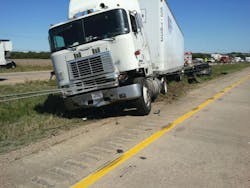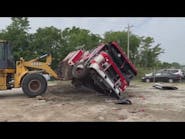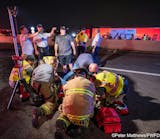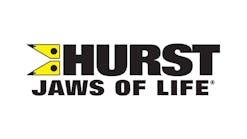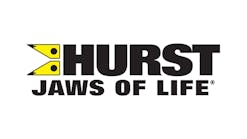University of Extrication: Cable Median Barriers — Part 2
SUBJECT: Cable Median Barriers — Part 2
TOPIC: Cable Median Barrier Incident Procedures
OBJECTIVE: Responders shall develop procedures for operations at center median incidents when a vehicle is contacting or entangled in tensioned cables
TASK: The rescue team shall develop a department guideline for incidents with vehicles in contact with the cable median barrier system based on the model eight-step procedure presented
In part two of our series on high-tension cable median barriers, we study a recommended eight-step procedure for dealing with vehicle collisions when tensioned cable barrier systems are involved. Using a real-world incident as our case study, we will work through this model step-by-step decision-making process that rescue officers can use to safely and effectively manage a cable barrier incident.
Decision Point 1, our first step in dealing with cable barriers, comes as we arrive at the incident. During our initial scene size-up, we must determine whether a cable median barrier system is present at the collision scene we are arriving at. If cables are present, then Decision Point 2, our next step, is to determine whether the damaged vehicles are contacting any of the three or four cables in any way. If all vehicles are clear of the cables, then standard operating procedures (SOPs) can be followed for dealing with the incident as if the cables weren't even there.
If the vehicles are contacting the cable system, then during Decision Point 3 we determine to what degree the cables are obstructing the crash-damaged vehicles. Rescue personnel typically obtain access to occupants of vehicles by opening a door. The degree of obstruction presented by the cables must therefore focus on whether any doors are blocked and whether side windows, the windshield, or the roof area of the vehicle are directly contacted by the high-tension cables. If the occupants got out of their vehicle before you arrived, then cable contact is less important. If, however, one entire side of the vehicle is blocked and you determined that opening those doors will be required to get the patients out, then responders must continue dealing with the cables.
Decision Point 4 involves determining whether the obstructing cables can be moved manually. It may be possible for several crew members to move the cables enough to allow a door to be opened or the roof to be taken off. If there is no slack in the cables, making them too difficult to move manually, then responders can continue on to the next tactic.
Decision Point 5 involves relaxing the tension on the obstructing cable or cables in a controlled manner. To do this, personnel with tools such as large pipe wrenches, locate the cable turnbuckles that are on each side of the incident scene. Remember, each cable run is approximately 1,000 feet in length. At this interval, a turnbuckle assembly will be present that allows the next run of cable to be joined and tension to be placed on the cable itself. Once the turnbuckles are located on each side of the incident scene, crews can release tension by backing off the turnbuckles. If this is successful, enough slack may be introduced that the obstructing cables can now be moved. If relaxing the turnbuckles still does not allow the obstructing cable to be moved, then we continue on to our next tactic.
Decision Point 6 involves efforts to manually move or remove the supporting posts. By moving the posts or removing them from their sockets, additional slack may be introduced into the cable that is obstructing your patient's vehicle. Be careful when moving a post out of its ground mount. If it is stressed or the nearby cable is stretched or twisted, anticipate any unwanted movement of the post as it is moved.
If all these efforts have been unsuccessful, then our "last resort" tactic will be to cut a turnbuckle or the cable itself. This is an involved process that should be attempted only after all the previous efforts have been tried and found unsuccessful. When cutting a tensioned cable, there is an inherent higher degree of risk for personnel at the incident scene; therefore, it must be done with due regard for safety.
Decision Point 7 requires responders to locate and prepare a suitable cut location. Your first choice for a location to cut should be a nearby turnbuckle itself. Prior to cutting, releasing tension at the turnbuckle should be completed. Cutting the turnbuckle instead of the cable makes it easier for transportation department personnel to repair the damaged system after the incident is cleared. If it is the cable itself that must be cut, multiple wraps of duct tape should be applied on both sides of the cut location to minimize fraying of the strands of the wire rope as it is cut. The location where you will cut the turnbuckle or the cable itself should be between two intact support poles where the cables are all running parallel and are not twisted or stressed.
Once the cut location is determined, the incident safety officer can establish a hazard zone and clear it of all personnel. The rescuer cutting the cable will obviously be the only person near the cable. It is understood that the rescuer doing the cutting will be in full PPE, including eye protection, full face protection and wearing heavy-duty gloves.
Decision Point 8, the cutting process, is begun once all preparations have been completed. A rescuer can use a rotary saw with an abrasive blade or a power rescue cutter to cut through the turnbuckle or the steel cable. Research has shown that when a cable is cut between two undamaged, intact support posts, the cable retracts straight back about 15 feet toward the posts in each direction.
TASK: The rescue team shall develop a department guideline for incidents with vehicles in contact with the cable median barrier system based on the model eight-step procedure presented.
RON MOORE, a Firehouse® contributing editor, is training chief for the McKinney, TX, Fire Department. He also authors a monthly online article in the Firehouse.com "MembersZone" and serves as the Forum Moderator for the extrication section of the Firehouse.com website. Moore can be contacted directly at [email protected].
Model Decision-making Protocol: Cable Median Barrier Incidents
Decision Point 1. Determine whether a cable median barrier system is present at the collision scene.
Decision Point 2. Determine whether the damaged vehicles are contacting any cables.
Decision Point 3. Determine to what degree the cables are obstructing the crash-damaged vehicles.
Decision Point 4. Determine whether the obstructing cables can be moved manually.
Decision Point 5. Relax the tension on the obstructing cable in a controlled manner, then re-try moving the obstructing cable.
Decision Point 6. Manually move or remove the supporting posts, then re-try moving the obstructing cable.
If the cable still obstructs, prepare for the "last resort" tactic of cutting the turnbuckle or the cable itself.
Decision Point 7. Locate and prepare a suitable cut location. Cut at the point located at the turnbuckle or at the cable between two intact support poles. Ensure that all cables are running parallel and are not twisted or stressed. Tension is released at the turnbuckle. A hazard zone is established and cleared of non-essential personnel. The rescuer with the cutting tool is in full PPE, including eye protection, full face protection, and wearing heavy-duty gloves. Multiple wraps of duct tape are applied on both sides of the cable cut location.
Decision Point 8. Use rotary saw with an abrasive blade or a power rescue cutter to cut through the turnbuckle or the steel cable.
Read Part 1 here.

Ron Moore
RON MOORE, who is a Firehouse contributing editor, recently retired as a division chief with the McKinney, TX, Fire Department and now serves with Prosper, TX, Fire Rescue. He self-published the Vehicle Rescue 1-2-3 training manual and serves as the forum moderator for the extrication section of Firehouse.com . Moore can be contacted directly at [email protected].
